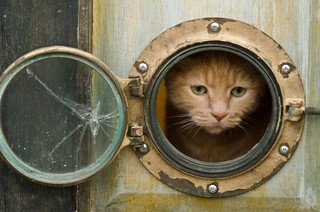Designing for Pets, Part II: 7 Pet-Safe Decor Tricks
In Designing for Pets, Part I, I showed some examples of how people are customizing their kitchens to accommodate pets. But what about the rest of the house?
According to the Humane Society, 164 million (or 62%) of American households have pets. While you know that your house would not feel like home without your adored pet, do you sometimes think it might look just a bit less worn? If your favorite sofa has suffered the indignity of cat scratches or if the gouges on your hardwood floor indicate that it is the runway of choice for man’s best friend, don’t despair. Following are some tips to help you decorate with pets in mind.
1. Focus on Flooring
Even small dogs can put substantial scratches into hardwood floors. You might consider placing area rugs in high traffic areas or replacing flooring with something more pet-friendly in rooms where your dog spends his time. If you love hardwood, be sure to use a durable sealant and keep your pet’s nails trimmed.
Cats cause less damage to hardwood but are famous for scattering little surprises around the house. There are many lovely scratch-resistant flooring materials available today that are resistant to pet wear and tear. Consider tile, Marmoleum, or cork as easy-care, pet-friendly alternatives.
Some flooring can also be coated with a sealant that is resistant to liquid spills, including pet urine.
2. Consider Before Carpeting
If you opt for carpeting, avoid white and light colors, as these will only showcase pet hair, dirty paw prints and other unsightly stains. Pick colors that are medium or dark-toned to mask dirt and dander.
Wool carpet may cost more than synthetic but will last longer and repel stains most easily. Select carpet that has cut pile, rather than loops that can be snagged by pet claws.
4. Fabrics
We love cats, but we don’t love their scratching! Upholstered furniture can create targets that are the perfect height for your feline to stretch upright and dig in her claws.
While keeping kitty’s nails trimmed is one of the best strategies for minimizing claw damage, there are also fabrics that are less inviting to cats. Look for tight weave fabrics that have stain-repellent qualities. Microfibers and suede can work well.
To test before you buy, try lightly running a piece of jewelry with prongs over a sample of the fabric. If the prongs of your ring catch the fabric, you know that cat claws will catch it as well.
If there are brocade or rough-weave fabrics that you just have to have in your living areas, consider reserving these for throw pillows or seat cushions that can be replaced periodically if they become worn. Also avoid furniture that has a lot of tufting, pleats, or piping, as these also are attractive to habitual scratchers.
5. Window Coverings
When selecting fabrics for window coverings, consider the same recommendations given for upholstery fabrics above. If your pet likes to climb or chew on curtains, consider shorter-length drapes rather than floor-length, or try dense, heavy fabrics like velvet that may not be as appealing to pets.
Blinds may also be a good choice, but since dangling shade cords can be dangerous to pets, consider continuous loop cords, and tether all cords to the wall.
6. Pet-Free Zones
To preserve some rooms of your home from pet ravages over time, consider adding French or other glass-pane doors to your living or dining room. This will still allow light and line-of-sight into these rooms, while keeping them pristine.
7. A Place of Their Own: Think “Diversion”
Here is a fun, elaborate built-in climbing structure to keep cats busy in the kitchen (and off the counters!).
If you provide your pet with acceptable places to snooze, bask, and scratch, they will be less likely to shed on your favorite chair. There is a wide selection of attractive pet beds and scratching posts available today that can be discreetly placed in strategic spots in your home. Cozy, washable throw blankets can also become the main attraction for pets.
Create a “safe room” for pets where they can be confined when necessary. (Perhaps you don’t want Spot “greeting” the repairman, or Tiger crawling into the lap of your allergic dinner guest.) Be sure to include access to food, water, a sanitary pad or box, toys, and something comfy to rest on.




